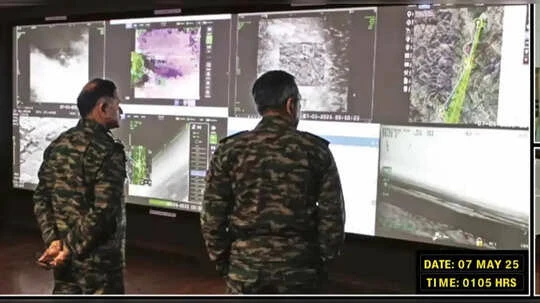Pakistan has long relied on ‘semi-state’ actors as instruments of state policy to counter India’s dominance in many domains. It was not surprising that serving army and police personnel were present at some of the funerals of those killed in India’s counter-terror strike,” said IISS or the International Institute for Strategic Studies, a British think tank, in a recent paper.
It stated that the Indian armed forces’ strike on May 7 did not target civilians or military infrastructure. And it named the ‘semi-state actors’: the Lashkar-e-Taiba and the Jaish-e-Mohammed which “targeted Indian civilians.” Those killed in the May 7 strike, said IISS, included “Mudassar Khadian Khas, who was responsible for the terrorist-training centre Markaz Taiba, and two brothers-in-law of Masood Azhar, the Jaish-e-Mohammed leader, who were involved in financial operations and weapons training.” But the leaders of both organisations are alive and have “vowed to retaliate against India. Another Pakistan-based terror attack against India therefore appears likely in the short term, unless the Pakistan security establishment actively and visibly takes action against them.”
The IISS said that “if the Pakistani security establishment were to shutter militant groups threatening India, New Delhi would likely ease the restrictions on Pakistan’s water supply.” The “security establishment,” of course, includes the ISI, Pakistan’s military intelligence agency and the restrictions on water supply relate to India’s decision to hold the Indus Water Treaty ‘in abeyance’ with immediate effect. Referring to the 88-hour conflict as the “most significant military escalation” in decades, IISS said “the boldness of India’s choice of targets was unprecedented; these included nine militant sites, with some in Pakistan’s heartland province of Punjab and at least eight major air bases, include Nur Khan in Rawalpindi and Mushaf in Sargodha. India’s three military branches sought escalation dominance against the Pakistani military throughout the conflict.”
Speaking about India’s decision on the Indus Water Treaty, IISS said New Delhi’s decision “can cause severe disruptions in Pakistan’s irrigation planning and disaster preparedness, thereby negatively affecting agriculture.” The short-term measures were already in place and closing the sluice gates of the Salal and Baglihar hydropower dams could reduce water flows during sowing season, affecting cotton, maize, rice and sugarcane crops. Wheat production in the winter could also suffer as also, hydropower production. “India is reportedly accelerating the construction of reservoir and hydropower projects on the India, Chenab and Jhelum rivers. This could affect all crop yields within three to five years,” the paper said. The IISS report suggests that even if China tries to reduce the Brahmaputra’s water flows, it won’t be very successful as 75 percent of the river’s water comes from snow melt, rain and tributaries within India. Even before the Pahalgam terror attack, which led to the conflict, India had wanted to renegotiate the Indus Water Treaty keeping in mind climate change, population growth and hydropower technology, but Pakistan had refused.
The IISS paper also mentioned defence minister Rajnath Singh’s warnings about India’s response to further terror attacks would have the Indian Navy “in the opening role.” He had added that if the Navy had been fully involved in the May fighting, Pakistan would have been broken into four parts.
